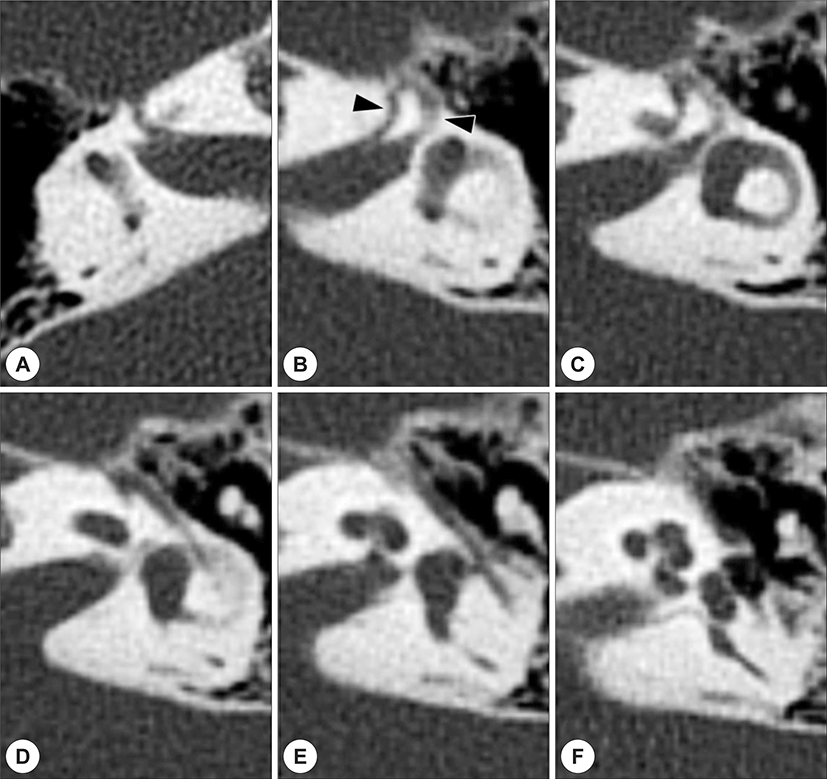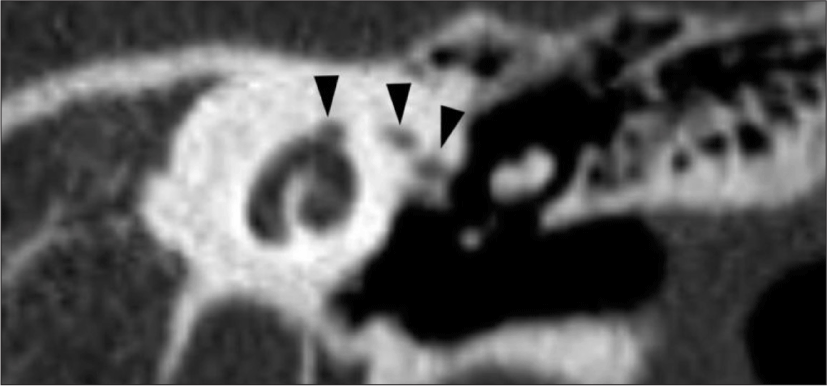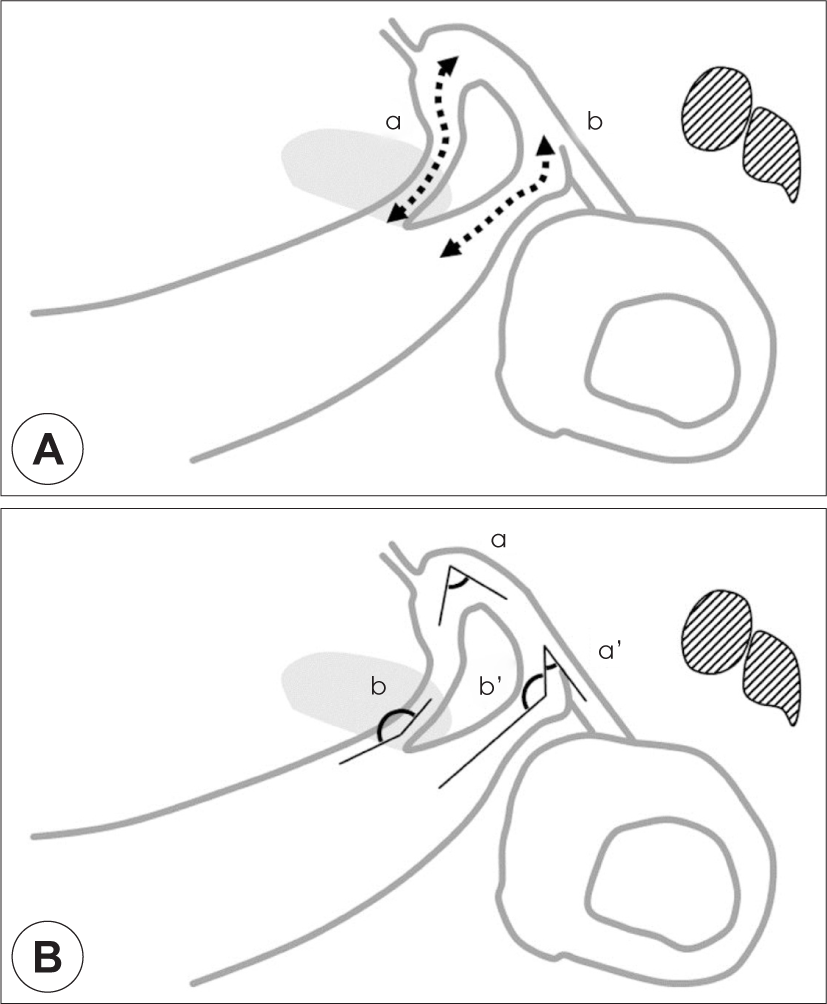Introduction
Although many congenital anomalies of the ear or syndrome including them present the possibility of anomalous facial nerve, isolated variations in facial nerve anatomy can occur. Consequently, it is important for the otologist to know many variations or anomalies of the facial nerve. Of various anomalies of the facial nerve anatomy, congenital bony dehiscence of the fallopian canal is the most common abnormality encountered.
Thorough understanding of anatomical variations of the facial nerve is very important, because the facial nerve anomalies are usually accompanied by the middle and inner ear malformations.1,2) Bifurcation or duplication of the facial nerve can be found in any segment of the facial nerve and is most commonly found in its tympanic segment.3,4) On the other hand, bifurcation of the labyrinthine segment is reported as the rarest of the facial nerve anomalies. Glastonbury et al.2) stated that Nager’s citation of two German articles was only English language reports of labyrinthine bifurcations. Here, we describe a case of bifurcation of labyrinthine segment of the facial nerve in 9-year old girl, which was accompanied by the narrow bony cochlear nerve canal.
Case Report
A 9-year old girl came to the outpatient clinic to evaluate her hearing level with 1-year history of left hearing loss, which was detected incidentally by herself. She did not have any past medical history except for tonsillectomy and adenoidectomy, which was done at our hospital 4 years ago. There was no history of universal hearing screening at birth. On physical examination, tympanic membrane and external auditory canal of both ears was normal and facial weakness was not found. She denied any history of tinnitus.
Pure-tone audiometry revealed that sensorineural hearing loss of four-frequency pure-tone average of 66 dB HL (hearing level), speech recognition threshold of 75 dB HL and speech discrimination score of 0% in left ear. Hearing level of right ear was within normal of four-frequency pure-tone average of 15 dB HL, speech recognition threshold of 15 dB HL and speech discrimination score of 100%.
A high-resolution computed tomography (CT) of temporal bone demonstrated the narrow bony cochlear nerve canal on left side, which was pointed out as a cause of her left sensorineural hearing loss. It also showed the bifurcation of the labyrinthine segment of her left facial nerve (Fig. 1, 2). There was no finding suggestive of bony dehiscent fallopian canal in this case. Using a PACS (Picture archiving and communication system) workstation (Macroview ; Infinitt, Seoul, Korea), several dimensions of bifurcated labyrinthine segments of fallopian canal (Fig. 3). The length of front labyrinthine segment was 4.42 mm and axial diameter was variable along its course (0.63 to 0.88 mm). The length of rear one was 4.02 mm and axial diameter was variable along its course (0.88 to 1.58 mm). For front labyrinthine segments of fallopian canal, angle between internal auditory canal and labyrinthine segments was 134 degree and that between labyrinthine and tym-panic segments was 37 degree. For rear one, angles between internal auditory canal and labyrinthine segments and between labyrinthine and tympanic segments were 103 and 23 degree, respectively. The diameter of bony cochlear nerve canal was measured manually at the mid-modiolar level and 0.39 mm in ipsilateral and 1.81 mm in contralateral cochleas.



Considering previous report of a case with bifurcation of the labyrinthine segment accompanied by Klippel-Feil syndrome, she got examination of pediatrician and there was no abnormality of spine or palate.
Considering unilateral sensorineural hearing loss (four-frequency pure-tone average=66 dB HL, pure-tone average of 2, 3, and 4 kHz=68 dB HL, speech recognition threshold of 75 dB HL), left hearing aid of completely-in-canal (CIC) type was tried at first. However, her audibility was not improved maybe due to too poor speech discrimination, she thought that a hearing aid was annoying, and she denied a hearing aid finally after 1 month-wearing. Because the duration of hearing loss was long (maybe 9 years) and her parents did not want any surgery, cochlear implant was not considered. Contralateral routing of signals (CROS) hearing aid was considered but not adopted. At present, further hearing rehabilitation was not planned and regular audiologic tests was scheduled.
Discussion
Various anomalies of the fallopian canal have been reported previously. The most common variation is a congenital bony dehiscence of the fallopian canal. Baxter5) reported the incidence of bony dehiscent fallopian canal was 55% in otherwise normal temporal bones. Moreano et al.6) analyzed 1,000 temporal bones with microscopic examination and reported that at least one facial canal dehiscence was found in 56% and bilateral prevalence was 76.3%. Due to its high prevalence, this anomaly was even regarded as normal variation.5-7)
Bifurcation or trifurcation of the fallopian canal is rare congenital anomaly. While any segment of the facial nerve can be involved in this variation, a tympanic segment is known as the most common portion, especially at the anterior or superior area of oval window.2-4) Bifurcation of mastoid segment is also previously reported.8,9) However, bifurcation of the labyrinthine segment has been seldom reported.10) Glastonbury et al.2) reported a case of 6-year-old girl with bilateral mixed hearing loss showing unilateral bifurcation of the labyrinthine segment as well as dilated posterior semicircular canal. Tehrani et al.11) also reported a case of 2 years-old girl with Klippel-Feil syndrome, whose CT demonstrated unilateral bifurcation of the labyrinthine segment of the facial nerve as well as other intratemporal anomalies including common cavity anomalies and narrow internal acoustic canals of both ears. Jin et al.12) reported a case showing the bifurcation of the labyrinthine segment of unilateral facial nerve without accompanying middle and inner ear malformation. They analyzed 45 ears of 24 cases and classified the variations in the labyrinthine segment of the facial nerve into 5 types ; 1) bony dehiscence in the geniculate fossa (55.5%), 2) anteromedial displacement of its course at the beginning site (60.0%), 3) enlargement of the first genu (66.7%), 4) increase of its length (66.7%), and 5) its bifurcation (2.2%).
In our case, bifurcation of the labyrinthine segment was found only unilaterally. CT showed that two branches of the facial nerve came out from internal auditory canal with separate bony canals at the labyrinthine segment. Glastonbury et al.2) pointed out that one branch of bifurcation is the facial nerve itself and the other is thought to be the nervus intermedius. Jin et al.12) also stated that the latter nerve is more slender, but the two bony canals have similar diameter. According these statements, we assumed that anterior canal of bifurcation was for the nervus intermedius and posterior one was for the facial nerve.13)
Abnormal bifurcation of the facial nerve may occur at the early embryonic stage but we know little about the mechanism of facial nerve bifurcation. Because facial and acoustic components develop separately, this bifurcation malformation of the facial nerve is not necessarily accompanied by other malformations of inner ear anomaly. However, our case was accompanied by ipsilateral narrow bony cochlear nerve canal. The diameter of bony cochlear nerve canal in this case was 0.39 mm in the same side as bifurcated facial nerve, which suggests that cochlear nerve may be hypoplastic.14) Several studies showed narrowed or stenotic bony cochlear nerve canal can cause congenital sensorineural hearing loss.14,15) Lim et al.15) stated that stenotic bony cochlear nerve canal is a potential cause of uni-lateral sensorineural hearing loss. Because the bony cochlear nerve canal encases the cochlear nerve, it has been known that its stenosis suggests the marker of anatomic or functional deficiency of the cochlear nerve. There was no literature reporting the epidemiology of simultaneous expression of stenotic bony cochlear nerve canal and bifurcated facial nerve.
Using high resolution CT, we present that the facial nerve were duplicated at the labyrinthine segment and they merged together at the genu in our case, which is shown clearly in Fig. 1B. However, CT do not present any information of the bifurcated nerves themselves because CT image shows only bony fallopian canal in the temporal bone. When CT reveals abnormal course of a fallopian canal, it is necessary to check out MRI to find out detail information of facial nerve.
Conclusion
We described a case of 9-year old girl with sensorineural hearing loss and bifurcation of labyrinthine segment of the facial nerve. Structural anomaly of facial nerve can be accompanied by the middle or inner ear malformations. Therefore, it is necessary to evaluate CT images in the patients with congenital hearing loss. This can be helpful to make correct diagnosis and to avoid potential damage during the surgery including cochlear implantation.
